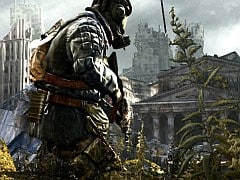Video Gamer is reader-supported. When you buy through links on our site, we may earn an affiliate commission. Prices subject to change. Learn more
Metro 2033 felt like a game that was trying to punch above its weight. It was an uneven affair, an FPS with great ambitions that were never quite fulfilled. Even so, there was a lot to like: it was a relentlessly bleak adventure, set in a vividly imagined world. It was no masterpiece, but it was an underdog effort that tried hard to please – and for this it was rewarded with a sizeable audience that was largely happy to overlook the weaker elements.
Two years later, Metro: Last Light looks to be following a similar gameplay template – and that’s fair enough, really. It’s increasingly rare to find a first-person shooter focusing on a single-player, narrative driven experience, and games based upon Russian indie novels are hardly ten-a-penny. Unlike the last game, Last Light doesn’t take any direct plot cues from the work of Dmitry Glukhovsky, but we still look to be exploring similar radioactive ground. Atmospheric exploration is the order of the day, punctuated by scrappy gun battles at regular intervals.
Broadly speaking, Metro’s scenarios seem to fall into two camps: struggles with mutants against the backdrop of ruined Moscow, and underground shoot-outs against other human survivors; invariably these are either Nazis or Communists, presumably because all that survived the nuclear holocaust was one copy of Mein Kampf, and one of Das Kapital. (Who knows? If someone had found an old Where’s Wally? Book, you’d probably be blasting away good-natured nerds in bobble hats. But I digress.)
The oft-repeated E3 2011 demo for Last Light showed us one of the claustrophobic engagements below ground, so it’s no surprise that THQ’s new showing takes us back to the surface. In many ways it’s a typical Metro setup – a quick jaunt across hostile territory, made complicated by ruined urban terrain, packs of mutants and the need to scavenge for supplies. As the case often was in 2033, the player character, Artyom, is accompanied by an NPC who acts as something akin to a commentator, chattering away in a Russian accent and providing a guide to proceedings.
And what is there to talk about? Well, the primary thing is a mandatory leap in appearance. The first game certainly had its moments to shine – especially on the PC build – but as you’d hope after a two year hiatus, Last Light offers a significant step up. As the player emerges from darkness and takes in the ruined cityscape for the first time, light rain begins to fall upon the shattered concrete, which is now being reclaimed by post-apocalyptic plant life. It’s a ripe, organic-looking playground that immediately invites a roving eye, though the best details are the smaller ones: wall-bound spiders scuttling away from your torchlight, and Arytom wiping sweat and dust from the visor of his gas mask. The original game was full of these immersive first-person flourishes, and once again most of your HUD elements are woven into in-game elements, like wristwatches and weapon indicators.
The demo’s stand-out moment occurs as Artyom and his mate explore the ruins of an airliner that crashed, long ago, into the building they’re trying to reach. As the pair pick their way through rows of passenger seats, skeletal cadavers still tightly buckled in, hallucinatory flashes begin to intrude upon the player’s vision. Upon reaching the cockpit, these flickers give way to a full-born out of body experience – transporting us to the moment when the pilots lost control of the plane, following the EMP of a nuclear strike on the city. The cabin lights dim, then the crew scream, bicker and pray in Russian as downtown Moscow rushes towards the cockpit window. It’s a grim, drawn-out scene, and when reality returns you find you friend is choking to death, having removed his mask as he was tripping.
It’s an undeniably punchy set-piece, and while devoid of player interaction, it’s more exciting than the ensuing combat sequence that follows. That’s not to say that the combat looks bad: though we’ll reserve final judgement till we’ve played for ourselves, gunplay appears a bit tighter and more satisfyingly percussive than in the last game. The mutants themselves boast far slicker animation, and while the desperate sprint to nearby sanctuary – the heavily-guarded gates of a survivor settlement – is the kind of thing we’ve seen many times before, the battle seems suitably intense.
No, it’s simply the case that atmosphere is still the strongest card that Metro: Last Light has to play. It may be no great departure from its predecessor, technical improvements aside, but 4A Games knows how to craft a world that we want to explore – a world that combines post-nuclear tragedy with the spice of constant danger, and imminent violence.
Metro: Last Light will be released on PC, PS3, and Xbox 360 next year.

/https://oimg.videogamer.com/images/fa32/metro_last_light_6.jpg)